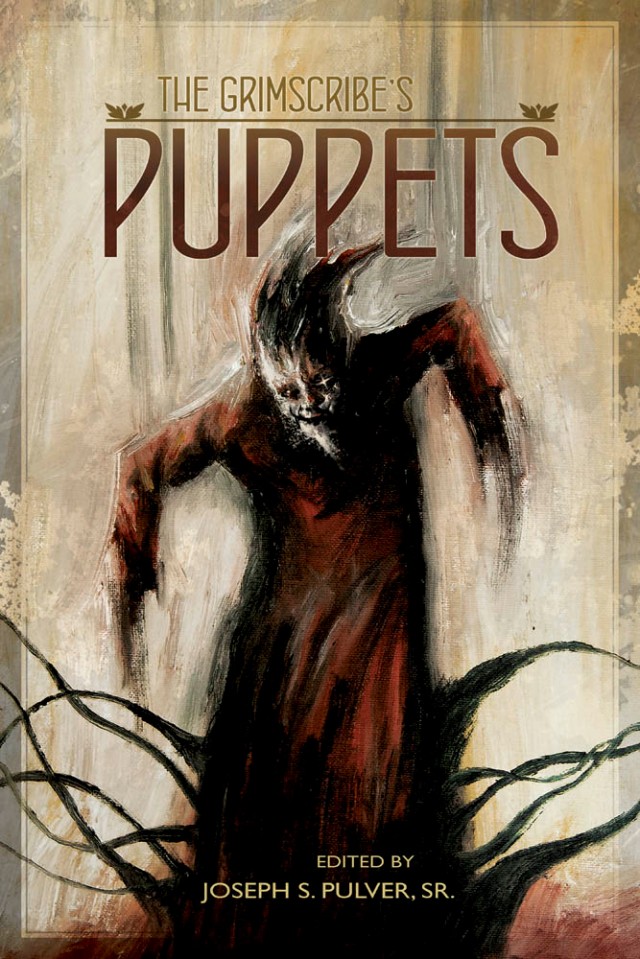In an earlier post, I mentioned the surprise reading. If you don’t know what I’m going on about, check out Reading Between Greats and come back.
Joe had already warned me and Scott Nicolay we must be present, so we had an idea he had some plans in store. When this picture was taken, Joe was up at the table fiddling with paper. That’s me, Lena, Scott Nicolay and Lady Lovecraft in front. Behind LL is Justin Steele, behind him Cody Goodfellow, and waaayyyy in the back, Laird Barron.

Joe, better known as Joseph S. Pulver Sr., read a story that will be published in S.T. Joshi’s “Mountains of Madness” themed anthology. In his introduction, Joe described his motivation in writing the story as trying to imagine “What if Laird Barron wrote a riff on At the Mountains of Madness?”
He carried along a copy of the anthology he edited, The Grimscribe’s Puppets, but didn’t read from it. This didn’t seem unusual. Lots of writers carry their latest book up to the table or stage during readings and panels, so people will see it and be mind-controlled into buying a copy.

Joe’s reading was excellent. He stopped about halfway through his story, and said he and Laird both felt strongly about the importance of helping boost newer writers by lending attention and offering endorsement.
He held up his copy of Grimscribe’s, said a few flattering things about me and about Scott Nicolay, and asked us to come up and read selections from our stories in that anthology. Me first.

I recall thinking “I should be really nervous.” I did feel on the spot, unsure how to begin. A story came to mind, a recurring dream I used to have about going to a David Bowie concert. I’d sit in the front row, and before the band started, Bowie would call me up to the stage and insist that I play guitar for them. I’m certainly no guitar player, but in the dream, I make a go of it, convinced that good intentions and zeal will allow me to bluff my way through, playing in place of Ronson, Fripp and Alomar.
I told the audience, “This feels something like that dream,” then read the beginning of “Diamond Dust.”

It seemed to go well, though that’s hard to gauge as it’s happening. People applauded.
Scott Nicolay came up, and wisely skipped the sort of preamble and introduction I offered. He read a chunk of his excellent tale, “Eyes Exchange Bank,” drawing laughs in all the right places.

Laird Barron came up last, and read the entirety of “D T” from the Pulver-edited King-in-Yellow-themed anthology, A Season in Carcosa. It’s a wonderful story, full of dark unease as well as humor, and pseudo-biographical portraits of recognizable figures, primarily Karl Edward Wagner.
I’ve read “D T” several times before, and very much enjoyed hearing it in Laird’s own voice.
The reading came full circle, from Joe mentioning Laird’s inspiration in his story, to Laird reading his story from a book edited by Joe. And in between, two writers with the highest respect for Barron and Pulver. This was a very special opportunity for Scott and me.

Afterward, many people came up and said nice things. We all signed many books, that is, Scott and I signed The Grimscribe’s Puppets, and Laird and Joe signed their many, various other things. I watched one guy pull out a stack of at least a dozen Barron collections, novels, and anthologies in which his stories appear.
There were questions about Grimscribe’s, and comments from a few who had already read it. One guy told me he was going to run upstairs, buy a copy, and hurry right back so Scott and I would sign it. Also in the room were other contributors to the same anthology, such as Richard Gavin, Cody Goodfellow and Simon Strantzas, so it was a great opportunity for a reader to grab several signatures, including that of Editor Pulver.
Later, when Scott, Lena and I went to lunch, a guy came into the burrito place and asked, “Was it you, just reading with Laird Barron and Joseph Pulver?”
I affirmed that we were. He said he’d enjoyed the reading, and had tried to buy the book, but found it sold out. I told him he must be wrong, that he should’ve asked at the Miskatonic River Press table, because I knew they’d had quite a few copies left before the reading.
It turned out he was right. There was at least some kind of run on these books after the reading. If Scott and I allow ourselves to imagine we had some part in creating a bit of buzz about the book, this is the greatest possible feeling. I’m already very grateful to be included in the book to begin with, and the reading was a wonderful treat.

The book is currently available from Amazon in three formats: Hardcover (of the casewrap variety, not cloth-cover-with-paper-dustjacket), Paperback and Kindle. Direct link HERE. You’ll also be able to grab it from Miskatonic Press, as soon as Tom Lynch obtains more copies, HERE.
Again, thanks to Joe Pulver, Laird Barron, Scott Nicolay, Tom Lynch, and everybody who attended the reading.













